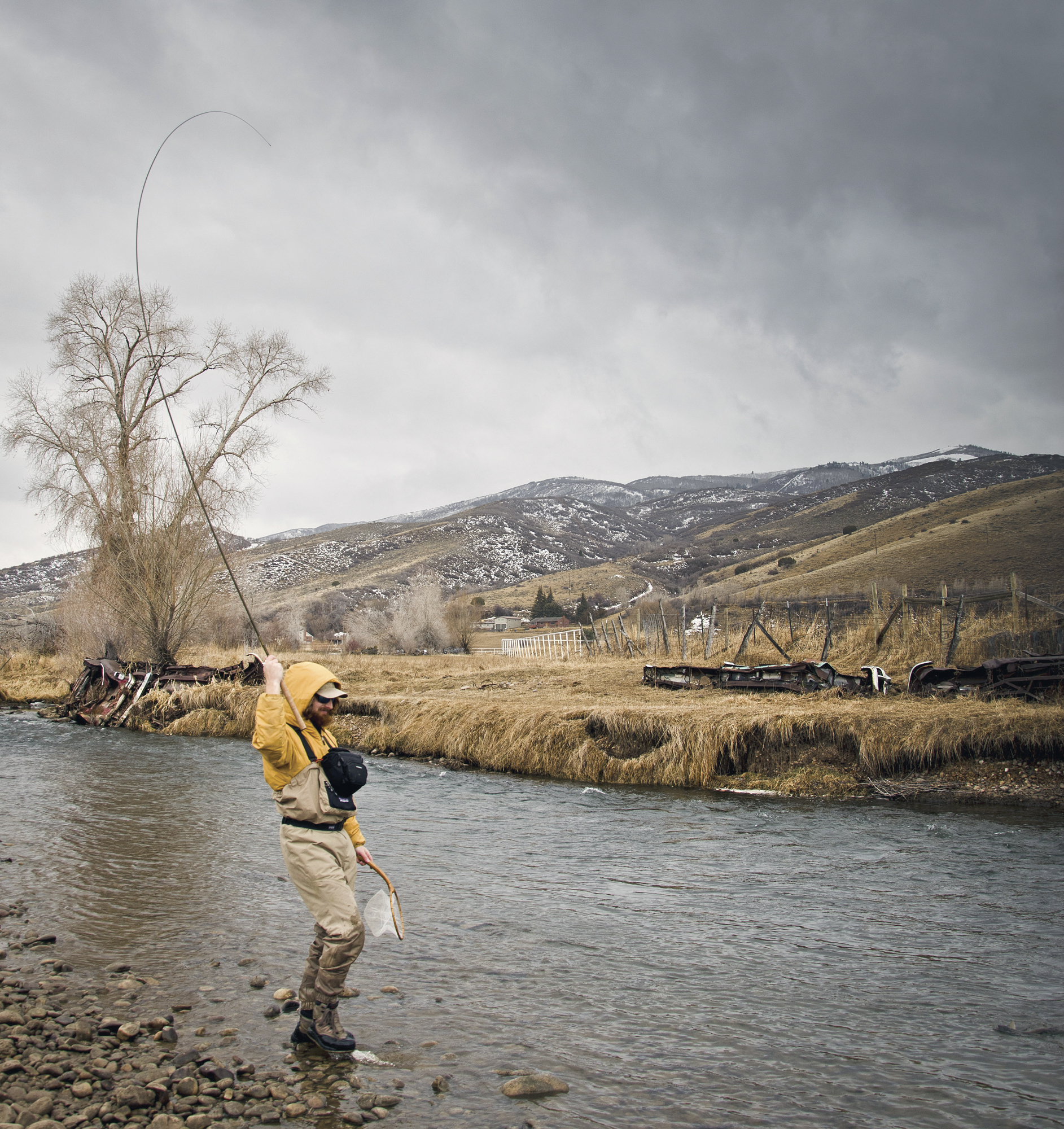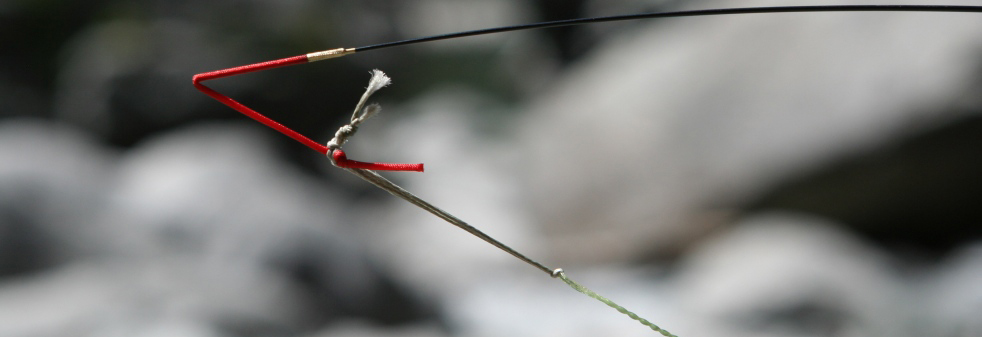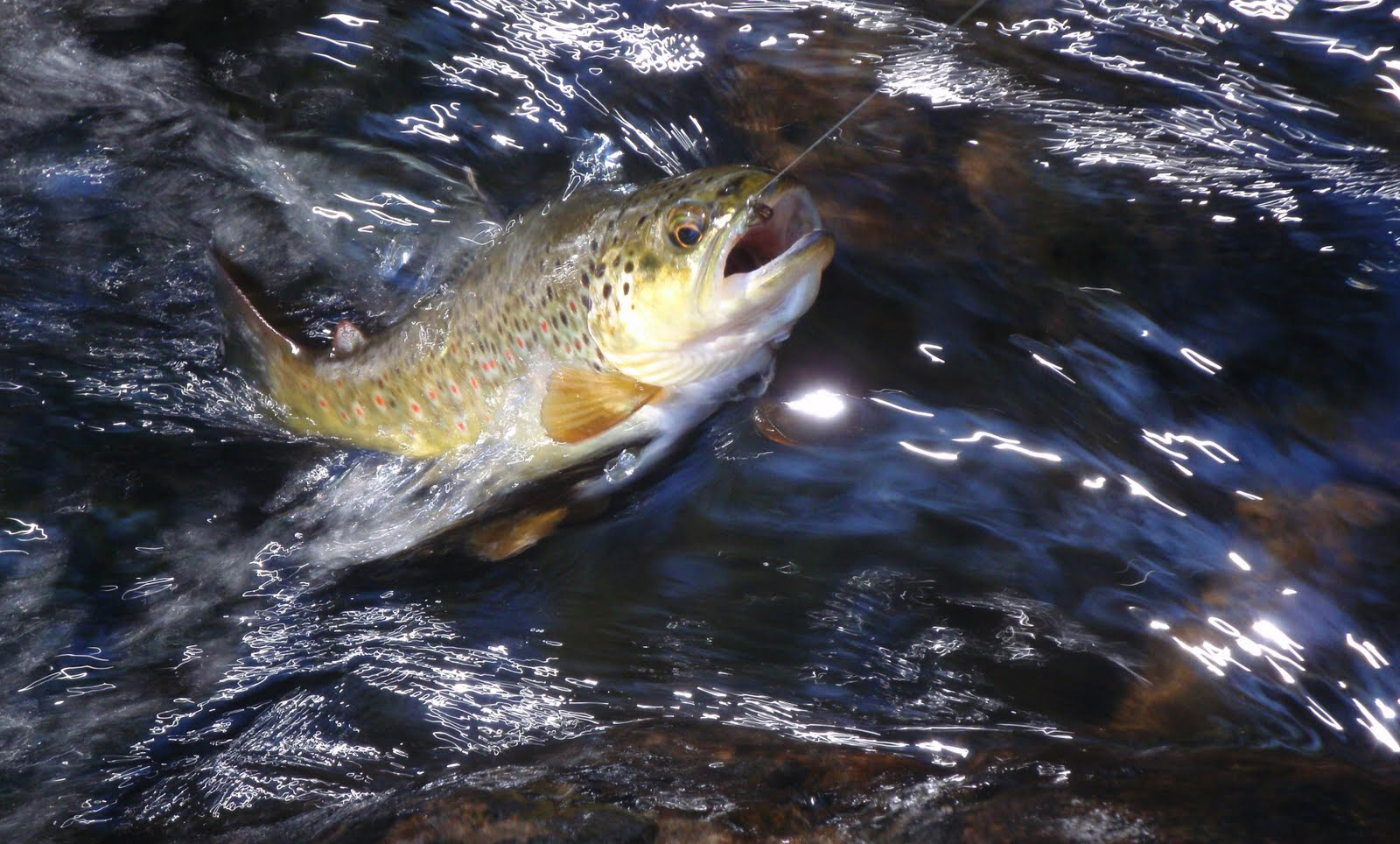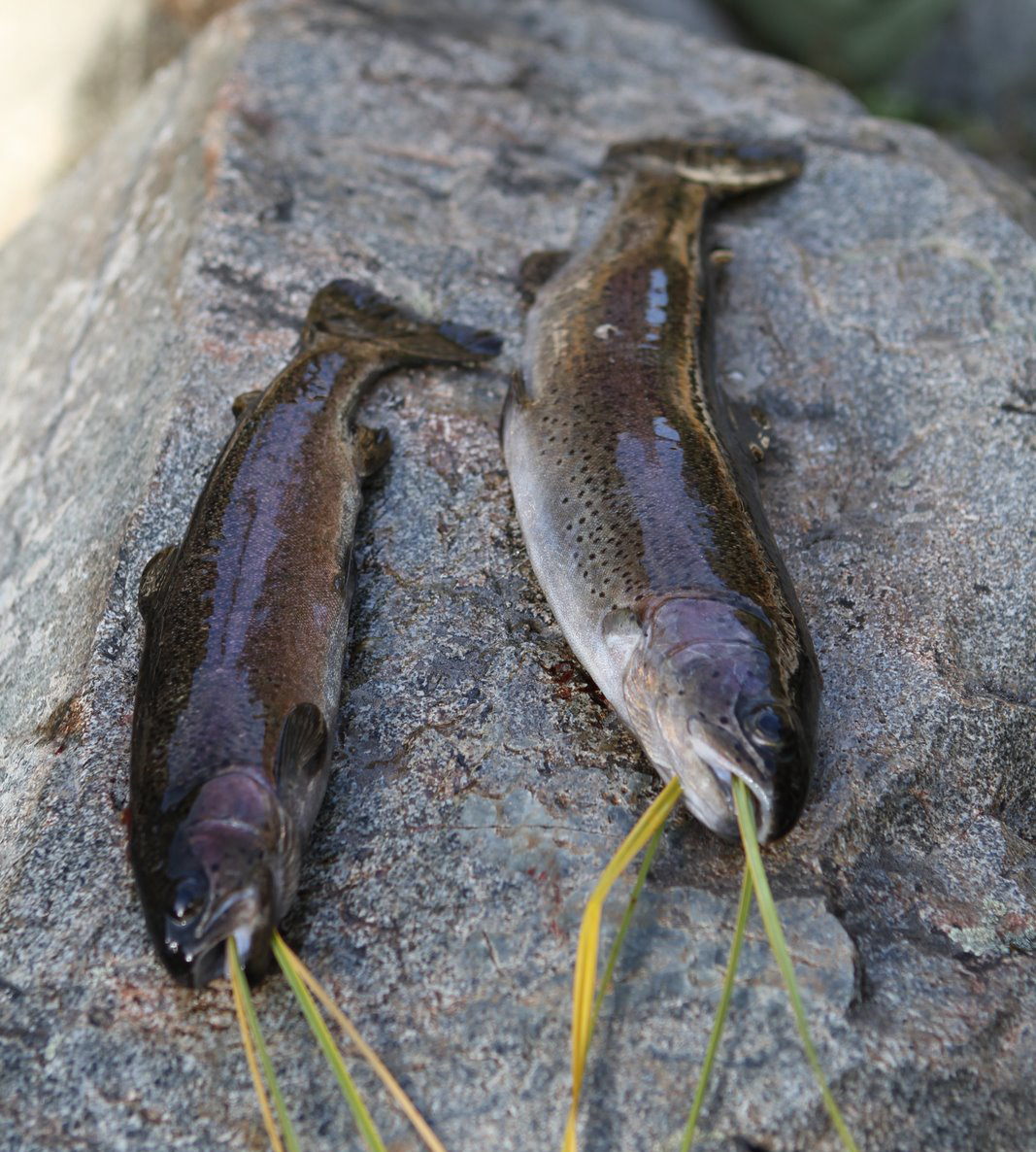
24 Jul Tenkara U.S.A.
MY FRIEND DAN THROWS PARTIES in the summertime. They are the big events of the season. People mill around the backyard drinking beer, laughing, and asking questions about politics and gardening. Last August, on a run from the yard to the kitchen, Dan bumped my arm by accident. His eyes lit up, he said, “Hanson,” and then he vanished into the basement.
Seconds later, I heard his voice bubbling from below. He said, “Hanson. Come down here. I want to show you something.”
At the bottom of the stairs, he stood holding a tube made out of thin metal — 2 inches thick and a little more than 2 feet long. Printed on the side were the words, “Tenkara U.S.A.”
I asked, “What is it?”
He said, “A fly rod.”
He unscrewed one end of the tube and pulled out a short, black stick with a wooden handle on the end.
He repeated, “It’s a fly rod.”
“Dan. That is a small, black wand. Do the kids have you reading the Harry Potter books again?”
He popped a cap off of the tip, and then he started pulling thin, telescoping sections out of the hollow staff. The pieces kept coming, one after another. When he finished, the rod extended out 12 feet. He passed the handle my direction.
“They’re Japanese. My sister worked on a project for the company that imports them.”
“Where is the reel seat? Where are the guides for the fly line? Why is it so long? Is this a cane pole?”
In the next two minutes, Dan explained how Japanese fly fishers tend not to use reels. They tie 10 or 12 feet of braided line to the end of their rods, and then they fling their flies like Huckleberry Finn.
“Daaaaaaaaad!”
Upstairs, five kids were chasing each other with implements from the garage. Dan set the rod against a chair and ran upstairs to quell the mayhem. Maybe it’s because I was drinking my third beer, and the situation felt surreal, or maybe it’s because I’m not receptive to new takes on old traditions, but either way I didn’t think too much about the telescoping pole. After my brief introduction, I forgot about Tenkara.
LYNN AND I CAMP on the west side of the Big Horn Mountains in the fall. In September, elk come out of the high country to bugle and mate in the rolling juniper and sagebrush. For three days we hike along ridges and down to the bottoms of valleys. We stroll through the woods and walk onto the prairie — listening. Shrill horns trumpet across the land.
We make camp on a sandbar in the middle of Sleeping Bear Creek. There are rapids on either side of the island, so it’s easy to walk across the creek on the tops of stones. We carry our gear to the site, pitch the tent and build a fire in the sand at water’s edge.
This year it takes longer than usual to haul our stuff to the campsite. As we get older, we seem to “require” more equipment: comfortable chairs, a deluxe coffee maker, a cooler full of small-batch beer. When the tent is set up and the fire is started, I ask the perennial question, “Do you mind if I go fishing?” It doesn’t bother Lynn. The truth is, once the fire is started, she plants herself next to the flames, and then nothing comes between her and the radiating heat.
I put my fly rod together and open up my fishing bag. It only takes a moment to rifle through the whole entire thing. Then I go through the pockets.
I cannot find my reel.
Lynn asks, “Did you check in the car?”
I say, “No. I did not check the car. It is not in the car. It’s on my desk.”
I cleaned my line two days before, and then set the reel in front of me so I could admire my attention to detail. Then I packed for the trip and left the reel beside my computer.
“Aaagh.”
I join Lynn next to the campfire. I stew and pout for 15 minutes. I hold my hands up near the flame. While I watch the fire leap from the sand, a trout rises on the water downriver. That is too much. I tell myself, “I have to figure something out.” I sift through my fishing bag and find a spool wound with tippet material. I pick it up and am struck by the thought of Tenkara. I start to wonder if I need a reel. I cut a 10-foot section and fix it to the last eyelet at the tip of the fly rod. Then I tie a bug to the end of the line.
I crouch and sneak upstream. Above the whitewater, the creek slows down and forms a pool. A school of trout hold themselves above the point where the current dives into the rocks.
I attempt to make a cast, but the effort is a disaster. The timing is different from anything that I have tried. Without a fly line, the tippet lingers in the air over the creek. I decide to practice on the shore. It feels like I am in slow motion, but I fall into a rhythm after five minutes. I discover it is possible to fling the fly: flick … wait, flick … wait, flick … wait. It seems ungraceful, but it works. I walk toward the stream with the tippet swinging back and forth. When I drop my fly on the water a trout swims up to the surface. Sip. Tug. The two of us are connected.
Out of habit, I reach for the reel with my left hand. There is no reel. There is no reel? I mutter, “Uh. Oh.” The trout scrambles through the pool while I think about what to do next, but he’s not interested in fighting. I set the rod down and then draw him toward the shore. This trout did not mind that I left my reel at home. I release him into the pool and he rejoins his companions.
During the next half an hour, in the horizontal light of dusk, I catch four more trout with 10 feet of tippet tied to the end of my custom-made McFarland rod. I suspect that I just voided the manufacturer’s warrantee by admitting as much, but what the heck. It’s all I could do, and it was fun. With a successful cast I could lob the fly no more than 15 feet. That meant I had to crouch on shore, slink over rocks, and creep up behind unsuspecting fish. Casting with no fly line or reel changed the nature of the angling experience.
Back at camp, I boasted to Lynn about the brook trout that I caught, and I described the technique born out of necessity.
She said, “You are a nut. Grab a beer and find some firewood.”
AT HOME, I START TO LOOK for information about Tenkara. It turns out there is just one group that promotes the practice. Tenkara U.S.A. maintains a Web site with information about the history of Japanese fishing, educational videos, and a catalog complete with flies and rods.
In English, the word “Tenkara” translates to something like the phrase, “From the sky.” Years ago, the Japanese discovered that most trout are caught within 10 or 20 feet of an angler. Culturally, the Japanese are also given to asceticism, and it is the combination of sober assessment and love of austerity that gave rise to Tenkara. It turns out that it doesn’t take much gear to make a fly fall onto the water 15 feet from where you stand.
A Tenkara fisher brings a minimal amount of equipment to the river — a pole, a braided line, and typically one type of fly. One type of fly? The Japanese do not strive to “match the hatch.” They learned a key lesson over the course of generations: trout like insects. If you present a fly properly, and the timing is right, one bug works about as well as another, especially on creeks in remote locations. Each Tenkara fisher has a favorite fly, but they’re all dry and they don’t carry a variety.
When I started reading about Tenkara, the philosophy gave me a sense that I had come home. I’ve always felt under-dressed because I do not wear a fishing vest full of 4,000 different fly patterns. I suddenly felt justified, with respect to my choice to cast an Adams in nearly every circumstance.
After growing familiar with Tenkara, I started to look at the catalog. The rods all telescope. They shrink to less than 20 inches, and they extend from 11 to 13 feet. There are six models to choose from. Like a good consumer, I began to analyze each rod with an eye toward making subtle distinctions. I spent two hours trying to weigh the costs and benefits of each rod’s length and characteristics.
Then I read a piece of advice in one of the forums posted on the Tenkara Web site. One of the group’s proprietors wrote, “Don’t sweat the decision. Each rod is good. Each one will serve you well. You’ll have fun no matter which model you choose.” That sounded reasonable, so I chose the one described as an “all-arounder.” I ordered a 12-foot “Ebisu.” I liked the thought that it was designed without a narrow purpose in mind, but the real selling point was the wooden handle — carved from red pine grown on the side of a mountain in Japan.
THIS FALL MY WIFE AND I DROVE over to Jackson Hole for a weekend in October. Jackson is stunning. The town sits underneath the Teton Range. The rugged peaks rise over the village, serving as a reminder of a time when the Earth sought to reach up toward the sky.
It’s a good place for Lynn and I to recreate. We both like to drink coffee and the town hosts several fine cafes. The landscape offers me a chance to fish and ride my mountain bike. Lynn likes to watch animals, and from that standpoint, it is the best destination in North America. My wife is also an artist, so she likes to peruse the galleries to see the work of regional painters. She draws inspiration from others, much in the same way that writers read outside of their genre.
I like to look at paintings, too. But I do not enjoy art as much as Lynn. After I’ve seen 40 renderings of the Grand Teton and its surrounding peaks, I’m ready for a change of venue. Lynn understands my short attention span where paintings are concerned, so when I ask if I can take an afternoon to fish the Buffalo Fork River, she says, “What a good idea.”
The Buffalo Fork drains the Continental Divide east of Teton National Park. It flows through a series of meadows before it pours into the Snake. It is late October, I am standing in what should be one of the coldest valleys in the nation, and I’m wearing cut-offs and a tee shirt. It is 70 degrees, the sun is shining, and the air is calm.
I can smell the freshly carved red pine when I take the Tenkara pole from its container. I extend each section out until the rod stands 12 feet tall. I tie a 10-foot length of braided line to the tip of the pole. Then I add a tippet and a fly. While I am in the parking lot I practice switching the rod back and forth. The fly swings slowly through the air and wafts onto the ground like a sparrow feather. When I reach with my arm I can loft a cast as far as 20 feet, but no farther. I start to realize this technique is going to take more strategy than I am accustomed to using.
On the shore, I begin to look for a pocket of water that could hide a school of trout. But I notice the water level is low on account of a long and dry summer. The stream looks like it’s been stripped to its skeleton. Deep runs shrunk into capillaries. I walk the bank looking for a place to cast a fly, but the river doesn’t offer any feeding lanes or refuges for trout — nowhere to toss a bug. Still, for the sake of practice, I throw my line onto the water.
The left side of my body starts to feel neglected. Once again, I’m fishing with no reel, so there’s no job for my left arm. I hold the pole with my right hand. I swish it back and forth to generate enough momentum to propel the line. It takes 20 minutes, but then the process begins to seem ordinary. I forget about the fact that I am not using a reel, and it occurs to me that this style of fishing is utterly silent.
With no clicks or whirs from a reel to draw my attention, I find myself focusing on the sound of air rustling through the sagebrush and prairie grasses. I am moved to look up at the dry leaves that remain on the branches of cottonwoods. I’m not making a sound, and I find myself in a moment of suspension. My ears tell my eyes where to look and my mind reaches out toward the water, through the treetops, and upstream beside the shore.
As I relax into the scene along the bank of the Buffalo Fork, it occurs to me that a moment of silence is the highest tribute we can pay to a person or place. It’s a deep and solemn way to offer an acknowledgment. We say, “Let us have a moment of silence.” Many religions accept quiet as an official method of concentration — a means of touching the divine.
When I was young, I used to watch the Roland Martin fishing show. During one of the episodes, I heard him declare: “You can’t catch a fish if your line is not in the water.” I took the message literally. Most of the time, if I am near a body of water, my line is in motion. Even so, after I finish practicing with the new rod, I keep my fly off the current unless I see a trout.
I let my ears lead me upstream. I fish for an hour, and I spot several fish holding in the deeper runs along the bank, but I can’t compel a fish to rise. The trout are reluctant to come out in the bright afternoon sun. They’re Snake River fine-spotted cutthroats. I’ve only caught a few of them. Before I knew what they were, I called them “blue-back” trout. When you see them through the water, their backs appear notably blue. They’re distinct from the well-known Yellowstone cutthroat. Historically, their range was limited to the Snake and its tributaries. They are handsome fish. Their smoky blue backs complement their tangerine pectoral fins.
It’s getting late, and I consider hiking back to the car, but upstream I notice a stretch of river where the current is diverted through a channel running in between a boulder and a half-sunk cottonwood. At the bottom of the channel, the water drops over a ridge and forms a pool with a surge of current swirling into its center. I creep along shore, doing my best to avoid casting a shadow onto the surface. When I get close, I swing the pole into motion. I drop the bug onto the river as it pours over the ledge at the top of the pool. The water sweeps the fly downstream for a moment — then a strike. A fish takes a swipe at the bug.
The trout swims for the deepest part of the pool. My rod bends and bounces with the fish as he wages a fight. Tenkara poles are soft and flexible. Even if you were inclined to, there is no way to dominate or redirect a fish, and I decide that’s just as well. It takes three minutes, maybe more, but eventually I lure the trout toward the bank. It’s a fine-spotted cutthroat. The fish looks healthy in spite of the low water. His orange fins send a smile across my face. I shake the hook out of his jaw, and then he slips back into the river.
THE RETURN TRIP TO JACKSON takes half an hour. It is nearly dark by the time I make it to our hotel room. When I return, I find Lynn on the balcony. She’s reading a copy of a book she bought while I was on my fishing trip. It’s a collection of essays on the lives and personalities of sandhill cranes. I pour a glass of water at the sink and join her outside on the porch. We are quiet for a minute. Neither one of us says anything. I start to feel my ears straining involuntarily. I think I hear my breath, but then I wonder — maybe it belongs to her.
- Photo courtesy of Tenkara U.S.A.
- Photo courtesy of Tenkara U.S.A.
- Photo courtesy of Tenkara U.S.A.
- Photo courtesy of Tenkara U.S.A.
- Photo courtesy of Tenkara U.S.A.








No Comments